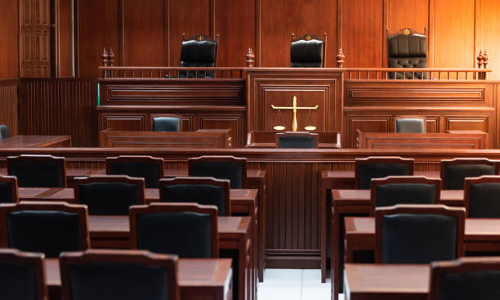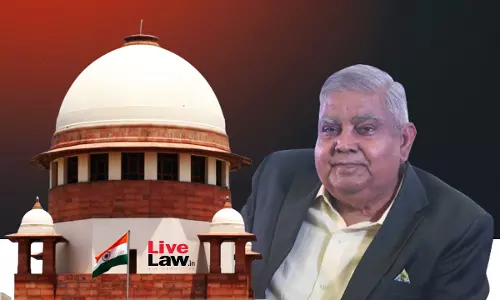“Corroboration” Under Section 157 Of The Evidence Act (Section 160 Of The Bharatiya Sakshya Adhiniyam [BSA] 2023
![“Corroboration” Under Section 157 Of The Evidence Act (Section 160 Of The Bharatiya Sakshya Adhiniyam [BSA] 2023 “Corroboration” Under Section 157 Of The Evidence Act (Section 160 Of The Bharatiya Sakshya Adhiniyam [BSA] 2023](https://www.livelaw.in/h-upload/2024/10/02/1500x900_563763-justice-v-ram-kumar-and-bharatiya-sakshya-adhiniyam-bsa.webp)
The later testimony of a witness can be “corroborated” by recourse to Section 157 of the Evidence Act. The said Section reads as follows:-“157: Former statements of witness may be proved to corroborate later testimony as to same fact.--In order to corroborate the testimony of a witness, any former statement made by such witness relating to the same fact at or about the time when the...
The later testimony of a witness can be “corroborated” by recourse to Section 157 of the Evidence Act. The said Section reads as follows:-
“157: Former statements of witness may be proved to corroborate later testimony as to same fact.--In order to corroborate the testimony of a witness, any former statement made by such witness relating to the same fact at or about the time when the fact took place, or before any authority legally competent to investigate the fact, may be proved.”
2. “Corroboration” means “confirmation” or “support” by additional evidence or authority; formal confirmation or ratification. Corroboration of a witness's testimony. (Vide Black's Law Dictionary).
“Corroboration” is nothing other than evidence which “confirms” or “supports” or “strengthens” other evidence. It is, in short, evidence which renders other evidence more probable. (Vide Director of Public Prosecutions v. Kilbourne (1973) 1 All ER 440 (H.L.) – Lord Simon – J).
While “substantive evidence” is evidence which can stand by itself, “corroborative evidence” cannot independently stand alone by itself. It can only support or strengthen other evidence.
Section 157 of the Evidence Act is an exception to the rule that a person cannot corroborate himself. (Vide Gauranga Charan Mohanti v. State of Orissa 1968 SCD 175 at 181 – 3 Judges – S M Sikri, J M Shelat, K. S. Hegde – JJ.)
3. Section 157 of the Evidence Act envisages two categories of statements of witnesses which can be used for “corroboration”. First is the statement made by a witness to any person “at or about the time when the fact took place”. The second is the statement made by him to “any authority legally bound to investigate the fact”. If the statement is made to an authority competent to investigate the fact such statement gains admissibility no matter whether it was made long after the incident. But if the statement was made to a private person, it loses its probative value due to lapse of time. If the statement was made contemporaneous with the occurrence the statement has a greater value as res gestae and then it is substantive evidence. But, if it was made only after some interval of time, the statement loses its probative utility as res gestae, but it is still usable all though only for a lesser use. (Vide para 26 of State of T. N. v. Suresh AIR 1998 SC 1044 = (1998) 2 SCC 372 – M. K. Mukherjee, K. T. Thomas - JJ.)
4. The meaning of “at or about the time when the fact took place” occurring in Section 157 of the Evidence Act.
No hard and fast rule can be applied. The main test is whether the statement was made as early as can reasonably be expected and before there was opportunity of tutoring or concoction. (Vide para 29 of Rameshwar v. State of Rajasthan AIR 1952 SC 54 = 1952 Cri.L.J. 547 – Fazl Ali, Vivian Bose – JJ – Held that the statement by the 8 year old rape victim to her mother about the occurrence after 4 hours which was explained also, amounted to corroboration from independent sources.)
5. Should not the “former statement” of a witness be in writing or reduced to writing ?
No. It is not necessary. It can be oral also. (Vide para 22 of Bhagwan Singh v. State of Punjab (I) AIR 1952 SC 214 = 1952 Cri.L.J. 1131 – Saiyid Fazl Ali, Vivian Bose – JJ.) (There an Illustration is given as below –
Witness stated in chief examination – “I saw the accused shoot “X”. In cross-examination he resiled and stated – “I did not see it at all.” The witness is then asked – “Didn't you tell “A”, “B”, “C” on the spot that you had seen the accused shoot “X” ? Witness replies – “Yes, I did.”
Here the admission by the witness that he told “A”, “B” and “C” of having seen the accused shoot “X” is a “corroboration”.
Here, the above statement of the witness to “A”, “B” and “C” was not reduced to writing and it was not made to the Police or a Magistrate. But the former statement of the witness cannot be used as substantive evidence. It can be used only for corroborating under Section 157 of the Evidence Act, the testimony of the witness given in his chief examination or can be used to shake the credit of the witness or to test his veracity under Section 146 of the Evidence Act. There is no application of Section 145 of the Evidence Act. In such a case resort to Section 145 would be necessary only if the witness “denies” that he made the former statement, provided the former statement was reduced to writing. But, in a case as the present the two conflicting versions were given in chief and in cross-examination. So, the prosecution was entitled to use the former statement either to contradict what was said in cross-examination or to corroborate what was said in chief examination. (Vide paras 22 to 24 of Bagwan Singh v. State of Punjab AIR 1952 SC 214 = 1952 Cri.L.J. 1131 – Saiyid Fazl Ali, Vivian Bose – J ).
6. The use to which an FIR can be put to.
a) An FIR can only be used as a previous statement for the purpose of either corroborating its maker under Section 157 of the Evidence Act or for contradicting him under Section 145 of the Evidence Act. It cannot be used for the purpose of corroborating or contradicting “other witnesses”. (Vide para 5 of Sk Hasib v. State of Bihar AIR 1972 SC 283 = (1972) 4 SCC 773 – 3 Judges – J M Shelat, I D Dua, S C Roy – JJ; Para 11 of Shankar v. State of U P AIR 1975 SC 757 = (1975) 3 SCC 851 – V R Krishna Iyer, R S Sarakaria – JJ; Para 7 of Babu Singh v. State of Punjab AIR 1996 SC 3250 = (1996) 8 SCC 699 – Faizan Uddin, G B Pattanaik – JJ.)
b) Section 154 of the Code of Criminal Procedure provides for the recording of the first information. The Information Report as such is not substantive evidence. It may be used to “corroborate” the informant under S.157 of the Evidence Act or to “contradict” him under S.145 of the Act, if the informant is called as a witness. If the First Information of an inculpatory nature is given by the accused himself, “the fact of his giving the information” is admissible against him as evidence of his conduct under Section 8 of the Evidence Act. If the information is a non-confessional statement, it is admissible against the accused as an “admission” under Section 21 of the Evidence Act and is relevant, see Faddi v. State of Madhya Pradesh AIR 1964 SC 1850 – M Hidayatullah, Raghubar Dayal - JJ, explaining Nisar Ali v. State of U.P., (S) AIR 1957 SC 366 – 3 Judges - Bhagwati, Sinha, Kapur – JJ and Dal Singh v. King Emperor, 44 Ind App 137: (AIR 1917 PC 25) – Viscount Haldane - J. But a confessional First Information Report to a Police Officer cannot be used against the accused in view of Section 25 of the Evidence Act. (Vide para 10 of Aghnoo Nagesia v. State of Bihar AIR 1966 SC 119 = 1966 Cri.L.J. 100 – 3 Judges – K Subba Rao, Raghubar Dayal, R S Bachawat – JJ.)
c) FIR can be used for corroborating the maker, provided the FIR has been duly admitted in evidence in accordance with the Evidence Act. Otherwise, the FIR cannot be used for corroborating the evidence of the maker. (Vide para 13 of Damodarprasad Chandrikaprasad v. State of Maharashtra AIR 1972 SC 622 = (1972) 1 SCC 107 - A. N. Ray, D. G. Palekar – JJ.)
(In the above decision the Supreme Court observed the use of an FIR for the following purposes –
(i) The first information report is not substantive evidence. It cannot be relied upon when it is not tendered in evidence in accordance with Section 157 of the Evidence Act when the first informant was examined thereby denying the accused an opportunity to cross-examine the first informant on the FIR.
(ii) It can be used for one of the limited purposes of corroborating or contradicting only the maker thereof.
(iii) Another purpose for which the first information report can be used is to show the implication of the accused to be not an afterthought.
(iv) The first information report can be used under S.32 (1) of the Evidence Act as to the cause of the persons' death or as part of the informant's conduct under S.8 of the Evidence Act. (Vide para 13.)
d) The testimony of the first informant before Court regarding the participation of the accused in the occurrence, was held to be corroborated by the FIR in which the names of the accused and the names of the eye-witness were mentioned. (Vide para 14 of Dargahi v. State of U P AIR 1973 SC 2695 = (1974) 3 SCC 302 -H. R. Khanna, A. Alagiriswami- JJ.)
7. Use of the “statement” of a witness under Section 164 Cr.P.C. for “contradicting” or “corroborating” the maker.
The “statement” of a witness under Section 164 Cr.P.C. can be used for contradicting and corroborating the witness. (Vide para 8 of Ram Kishan Singh v. Harmit Kaur AIR 1972 SC 468 = (1972) 3 SCC 280 - A. N. Ray, D. G. Palekar – JJ; Para 9 of Chandrasekharan v. State of Kerala 1993 (1) KLT 571 = 1993 KHC 92 – K T Thomas, K K Usha – JJ; Para 5 of Baij Nath Sah v. State of Bihar (2010) 6 SCC 736 = 2010 Cri.L.J. 3821 = 2010 (2) KHC 738 – Harjit Singh Bedi, C K Prasad – JJ.)
8. Use of a confessional soliloquy as corroborative evidence.
“Confessional soliloquy” are mutterings of a confused mind. It may be an expression of conflict of emotion, a conscious effort to stifle the pricked conscience. It is an argument to find excuse or justification for his act. It is a penitent or remorseful act of exaggeration of his part in the crime. The tone may be soft and low. The words may be confused. They may be capable of conflicting interpretations depending on the witnesses, whether they are biased or honest, intelligent or ignorant, imaginative or prosaic, as the case may be. Before such evidence of confessional soliloquy is accepted, it must be established by cogent evidence as to what were the exact words used by the accused.
Even if the evidence of confessional soliloquy has been found admissible, prudence and justice demand that such evidence cannot be made the sole ground of conviction. It can be used only as a corroborative piece of evidence. (Vide para 6 of Sahoo v. State of U.P. AIR 1966 SC 40 = 1966 Cri.L.J. 68 – 3 Judges – K. Subba Rao, J C Shah, R S Bachawat – JJ).
For example – A witness testifies before Court that in the night after the occurrence he heard the accused muttering to himself –
“He (the deceased) was a traitor and did not deserve to live. I was doing justice by finishing him off”.
9. The statement of prosecution witnesses examined under Section 200/202 Cr.P.C. can be used under Section 157 of the Evidence Act for corroborating their evidence when examined during trial. (Vide paras 80 and 110 – Q.I and III of Hardeep Singh v. State of Punjab AIR 2014 SC 1400 = (2014) 3 SCC 92 – 5 Judges – P. Sathasivam – CJI, Dr. B S Chauhan, Ranjana Prakash Desai, Ranjan Gogoi, S A Bobde- JJ.)
10. The statement of prosecution witnesses recorded during an inquiry under Section 202 Cr.P.C. cannot be used under Section 157 of the Evidence Act for corroborating the evidence of other witnesses examined during trial. (Vide para 11 of Sashi Jena v. Khadalswain AIR 2004 SC 1492 = (2004) 4 SCC 236 – Y K Sabharwal, B N Agrawal – JJ.)
11. The testimony of PW.12, the brother of the deceased who had accompanied the deceased, when the latter was attacked by the accused, was to the effect that he had narrated the whole incident to PW.5 who came there on hearing gunshots. The evidence of PW.5 that PW.12 had narrated to him the entire incident, is corroborated by the evidence of PW.12. (Vide para 9 of Ramashray Yadav v. State of Bihar AIR 2006 SC 201 = (2005) 13 SCC 468 – H.K. Sema, G. P. Mathur – JJ.)
12. The evidentiary value of a witness to a Panchanama.
A panchanama can be used as corroborative evidence under Section 157 of the Evidence Act when a Panch witness gives his evidence in Court. Such a witness can also use the Panchanama for refreshing his memory under Section 159 of the Evidence Act. (Vide para 354 of Yakub Abdul Razak Memon v. State of Maharashtra (2013) 13 SCC 1 – P. Sathasivam, Dr. B. S. Chauhan – JJ.)
Author is Former Judge, High Court of Kerala. Views Are Personal.




